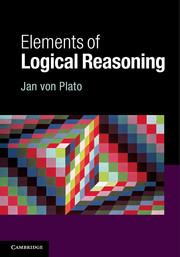Book contents
- Frontmatter
- Contents
- Preface
- PART I First steps in logical reasoning
- 1 Starting points
- 2 Rules of proof
- 3 Natural deduction
- 4 Proof search
- 5 Classical natural deduction
- 6 Proof search in classical logic
- 7 The semantics of propositional logic
- Part II Logical reasoning with the quantifiers
- Part III Beyond pure logic
- Part IV Complementary topics
- Suggestions for the use of this book
- Further reading
- Bibliography
- Index of names
- Index of subjects
5 - Classical natural deduction
Published online by Cambridge University Press: 05 June 2014
- Frontmatter
- Contents
- Preface
- PART I First steps in logical reasoning
- 1 Starting points
- 2 Rules of proof
- 3 Natural deduction
- 4 Proof search
- 5 Classical natural deduction
- 6 Proof search in classical logic
- 7 The semantics of propositional logic
- Part II Logical reasoning with the quantifiers
- Part III Beyond pure logic
- Part IV Complementary topics
- Suggestions for the use of this book
- Further reading
- Bibliography
- Index of names
- Index of subjects
Summary
Indirect proof
We showed in Section 3.7(a) that the law of double negation, ¬¬ A ⊃ A, is not derivable in intuitionistic logic. The proof of underivability was done with formal detail in Section 4.4, example (d). The difference between A and ¬¬ A was explained in Section 3.7(c): The former is a direct proposition, the latter expresses the impossibility of something negative, the best example being direct existence against the impossibility of non-existence. The former can be established by showing an object with a required property, the latter by showing that it is impossible that no object has the property.
One reason for the natural tendency to accept the law of double negation, or the related law of excluded middle, is as follows. If there is only a finite number of alternatives, the question of A or ¬ A can be decided by going through all of these. Say, if we claim, for natural numbers less than 100, that there are three and only three successive odd numbers that are all prime, we can go through all possible cases and find that 3, 5, and 7 are precisely those three numbers. More generally, the constructive interpretation of A ∨ ¬ A is that it expresses the decidability of A.
- Type
- Chapter
- Information
- Elements of Logical Reasoning , pp. 80 - 88Publisher: Cambridge University PressPrint publication year: 2014



